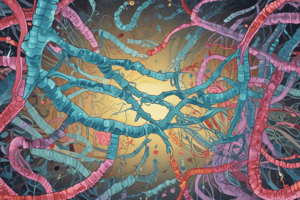Podcast
Questions and Answers
What is suggested about the integration of T-DNAs in the context of cotransformation?
What is suggested about the integration of T-DNAs in the context of cotransformation?
- T-DNAs will invariably integrate at linked sites.
- Cotransformation only occurs with a single T-DNA.
- T-DNAs will lead to the permanent loss of transgenes.
- T-DNAs can be integrated into unlinked sites. (correct)
Which of the following approaches is NOT used for cotransformation?
Which of the following approaches is NOT used for cotransformation?
- Introducing two T-DNAs from different bacteria.
- Introducing two T-DNAs within the same bacterium.
- Using T-DNAs located on the same replicon within a bacterium.
- Using one T-DNA from an unrelated organism. (correct)
What primarily induces the activity of virulence genes in Agrobacterium?
What primarily induces the activity of virulence genes in Agrobacterium?
- High temperatures.
- Chemical signals from plants.
- Induction by phenolic compounds. (correct)
- Nutrient-rich media.
What characterizes constitutive virA mutants in Agrobacterium?
What characterizes constitutive virA mutants in Agrobacterium?
Which statement about the cotransformation experiments is accurate?
Which statement about the cotransformation experiments is accurate?
Which variant is emphasized more in relation to increasing virulence gene induction?
Which variant is emphasized more in relation to increasing virulence gene induction?
What was the outcome of the earliest experiments using cotransformation?
What was the outcome of the earliest experiments using cotransformation?
What is indicated by the 'one-strain, two-replicon' approach in tobacco cell transformation?
What is indicated by the 'one-strain, two-replicon' approach in tobacco cell transformation?
What is the main purpose of using viral suppressors of silencing in plants?
What is the main purpose of using viral suppressors of silencing in plants?
Which strategy is mentioned for allowing only transient expression of gene products in plants?
Which strategy is mentioned for allowing only transient expression of gene products in plants?
What characteristic do nonintegrating T-DNA systems have?
What characteristic do nonintegrating T-DNA systems have?
What was the result of replacing certain amino acids in the VirD2 protein?
What was the result of replacing certain amino acids in the VirD2 protein?
What does the C-terminal domain termed 'ω' in VirD2 contribute to?
What does the C-terminal domain termed 'ω' in VirD2 contribute to?
Which statement about Agrobacterium-mediated transformation is true?
Which statement about Agrobacterium-mediated transformation is true?
What is the primary challenge with transforming certain inbred lines using Agrobacterium?
What is the primary challenge with transforming certain inbred lines using Agrobacterium?
What factor does not influence the success of Agrobacterium-mediated transformation?
What factor does not influence the success of Agrobacterium-mediated transformation?
What did Miranda et al. achieve by reversing the orientation of a T-DNA right border?
What did Miranda et al. achieve by reversing the orientation of a T-DNA right border?
What size of DNA molecules could be introduced into plants using Agrobacterium-mediated transformation according to the findings?
What size of DNA molecules could be introduced into plants using Agrobacterium-mediated transformation according to the findings?
What was the primary function of the VirD2 protein in the context of DNA transfer?
What was the primary function of the VirD2 protein in the context of DNA transfer?
In which plant species did the study find evidence of transferred binary vector backbone sequences?
In which plant species did the study find evidence of transferred binary vector backbone sequences?
What did Hamilton et al. develop to demonstrate directed transfer of large DNA molecules?
What did Hamilton et al. develop to demonstrate directed transfer of large DNA molecules?
What could result from either skipping the left T-DNA border when T-DNA was processed or initiating T-DNA transfer from the left border?
What could result from either skipping the left T-DNA border when T-DNA was processed or initiating T-DNA transfer from the left border?
What percentage of transgenic tobacco plants showed the presence of vector backbone sequences?
What percentage of transgenic tobacco plants showed the presence of vector backbone sequences?
What was a significant conclusion drawn from the research by Kononov et al. regarding the transfer mechanism?
What was a significant conclusion drawn from the research by Kononov et al. regarding the transfer mechanism?
What effect did overexpression of the phosphatase have in tobacco BY-2 cells?
What effect did overexpression of the phosphatase have in tobacco BY-2 cells?
Which proteins were identified as interacting with VirE2 in Arabidopsis?
Which proteins were identified as interacting with VirE2 in Arabidopsis?
What was the outcome when antisense inhibition of VIP1 expression was conducted?
What was the outcome when antisense inhibition of VIP1 expression was conducted?
How many Arabidopsis T-DNA insertion mutants resistant to Agrobacterium transformation have been identified so far?
How many Arabidopsis T-DNA insertion mutants resistant to Agrobacterium transformation have been identified so far?
What role does the RAT5 gene potentially play in the transformation process?
What role does the RAT5 gene potentially play in the transformation process?
Which of the following genes is NOT mentioned as potentially affecting cell wall structure?
Which of the following genes is NOT mentioned as potentially affecting cell wall structure?
What was the observed condition of bacterial attachment to the roots of the rat4 mutant?
What was the observed condition of bacterial attachment to the roots of the rat4 mutant?
Which function is associated with the protein identified as rat3?
Which function is associated with the protein identified as rat3?
What primarily results from the nicking of the T-DNA lower strand?
What primarily results from the nicking of the T-DNA lower strand?
What is the T-strand in the context of Agrobacterium transformation?
What is the T-strand in the context of Agrobacterium transformation?
Which protein establishes the polarity of T-DNA transfer?
Which protein establishes the polarity of T-DNA transfer?
What role does the VirD4 protein play in the T-DNA transfer process?
What role does the VirD4 protein play in the T-DNA transfer process?
How do VirB proteins contribute to the T-DNA transfer process?
How do VirB proteins contribute to the T-DNA transfer process?
What is a characteristic of VirB2 in the context of T-DNA transfer?
What is a characteristic of VirB2 in the context of T-DNA transfer?
What is the significance of right borders in T-DNA transfer relative to left borders?
What is the significance of right borders in T-DNA transfer relative to left borders?
Why is nicking of the left border significant in processing T-strands?
Why is nicking of the left border significant in processing T-strands?
Flashcards are hidden until you start studying
Study Notes
T-DNA Transfer and Plant Transformation
- Entire binary vector, including T-DNA and backbone sequences, can be transferred into plants to identify genes linked to phenotypes.
- A Ti plasmid with approximately 200 kbp of DNA can be mobilized into plants by reversing the orientation of the T-DNA right border.
- Very large DNA molecules can be introduced into plants via Agrobacterium-mediated transformation.
- The binary BAC (BIBAC) system allows the transfer of human DNA inserts up to 150 kbp into plant cells.
Cotransformation Strategies
- Three approaches for cotransformation include:
- Introduction of two T-DNAs from different bacteria.
- Introduction of two T-DNAs carried by distinct replicons in the same bacterium.
- Introduction of two T-DNAs on the same replicon within a bacterium.
- Cotransformation can result in the integration and segregation of various phenotypes in plants across generations.
Virulence Gene Regulation
- Virulence genes (vir genes) are activated by plant-produced phenolic compounds.
- Mutants of virA and virG have been identified that maintain activity without phenolic inducers, enhancing transformation efficiency.
- Inducer-independent virG mutants could potentially increase the efficiency of Agrobacterium transformation.
Non-integrating T-DNA Systems
- Development of systems that allow transient expression of gene products without integration into plant DNA is underway.
- Such systems utilize mutant Agrobacterium strains or specialized plant cells.
Mechanisms of T-DNA Transfer
- The VirD2 protein is crucial for DNA transfer, linking to the right border of T-DNA and establishing transfer polarity.
- A type IV secretion system, including 11 VirB proteins, is involved in T-DNA transfer, with virB proteins functioning in channel formation and energy provision.
Genetic Basis for Transformation Susceptibility
- Genetic screening has identified plant genes that influence susceptibility to Agrobacterium-mediated transformation.
- The identification of Arabidopsis T-DNA insertion mutants resistant to transformation, termed rat mutants, has led to insights into the transformation process.
- Key genes involved include those related to bacterial attachment to roots, such as genes encoding arabinogalactan proteins and plant cell wall components.
Future Directions in Plant Transformation
- Exploring modifications in virulence proteins and the genetic factors influencing Agrobacterium transformation may lead to enhanced transformation efficiencies in recalcitrant plant species.
- Overexpression of specific genes, such as histone H2A-1, could potentially improve transformation rates in difficult-to-transform plants.
Studying That Suits You
Use AI to generate personalized quizzes and flashcards to suit your learning preferences.




